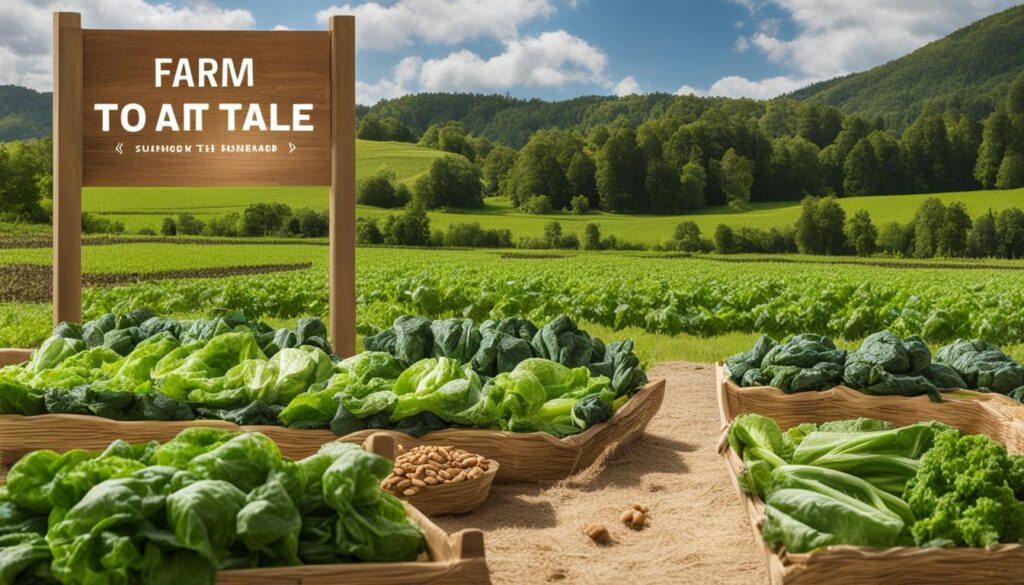Eating sustainably goes beyond simply choosing organic or plant-based options. It involves being mindful of the entire food production process, from farm to table. In this guide, I will explore the principles of sustainable eating, providing practical tips on how to embrace a greener lifestyle through local, organic, and seasonal food choices.
By adopting farm-to-table practices at home, we can not only support local farmers and reduce our carbon footprint but also enjoy the benefits of fresh, nutrient-rich food. Let’s dive into the world of sustainable eating and discover how we can make a positive impact on our health and the environment.
Key Takeaways:
- Embracing sustainable eating involves considering the entire food production process, from farm to table.
- Choosing locally-sourced, organic, and seasonal food options supports the local economy and reduces carbon emissions.
- Opting for plant-based choices can lower the environmental impact and offer health benefits.
- Making eco-friendly packaging and dining choices helps reduce single-use plastic waste.
- Implementing small changes like incorporating meatless meals and shopping at local farmers markets can make a big difference.
The Pillars of Sustainable Eating
In order to embrace sustainable eating practices, it is important to understand the pillars on which it stands. These pillars include eating locally-sourced foods, practicing seasonal eating, and reducing food waste.
Eating Locally-Sourced Foods
Eating locally-sourced foods is a key aspect of sustainable eating. By choosing foods that are produced and sourced from local farms, you not only support the local economy, but also reduce the carbon footprint associated with long-distance transportation. When you buy from local farmers, you establish a direct connection with the source of your food, ensuring its quality and freshness.
Seasonal Eating
Seasonal eating is another crucial pillar of sustainable eating. By consuming fruits, vegetables, and other foods that are in season, you can enjoy optimal taste and freshness. Additionally, seasonal eating minimizes the energy consumption required for the production and transportation of out-of-season produce. It encourages a closer connection with nature’s cycles and promotes variety in your diet.
Reducing Food Waste
Reducing food waste is an essential component of sustainable eating. Mindful shopping, meal planning, and repurposing leftovers can help in minimizing food waste. By purchasing only what you need and using leftovers creatively, you can make a significant difference in reducing food waste and its environmental impact. Additionally, composting is a great way to repurpose food scraps and turn them into nutrient-rich soil for your garden.
By incorporating these pillars into your eating habits, you can contribute to a more sustainable food system and make a positive impact on the environment.
| The Pillars of Sustainable Eating | |||
|---|---|---|---|
| Eating Locally-Sourced Foods | |||
| Benefits: | – Supports the local economy | – Reduces carbon footprint | – Ensures freshness and quality |
| Seasonal Eating | |||
| Benefits: | – Optimal taste and freshness | – Minimal energy consumption | – Diverse diet based on nature’s cycles |
| Reducing Food Waste | |||
| Benefits: | – Minimizes environmental impact | – Saves money | – Promotes mindful consumption |
“Eating locally-sourced foods, practicing seasonal eating, and reducing food waste are the pillars of sustainable eating.”
– Sustainable Food Advocate

Opting for Plant-Based Choices
When it comes to sustainable eating, one of the most impactful choices you can make is opting for plant-based options. Not only does this decision have a lower environmental impact, but it also offers numerous health benefits.
Compared to a meat-heavy diet, plant-based choices require fewer resources for production. They use less land, water, and energy, making them a more sustainable choice for our planet. By reducing the demand for animal agriculture, we can help mitigate deforestation, conserve water, and minimize greenhouse gas emissions.
But it’s not just the environment that benefits from plant-based choices; your health can also experience a positive transformation. Research has shown that a plant-based diet, rich in fruits, vegetables, whole grains, legumes, and nuts, can reduce the risk of chronic diseases such as heart disease, diabetes, and certain types of cancer.
The Power of Plants
Plants are packed with essential nutrients, vitamins, and minerals that support overall well-being. They are naturally low in saturated fats and cholesterol, promoting heart health and reducing the risk of high blood pressure. Additionally, plant-based foods are a great source of fiber, which aids digestion, helps control weight, and supports a healthy gut.
Another advantage of plant-based choices is their versatility. With a wide variety of fruits, vegetables, grains, and legumes available, you can create delicious and satisfying meals that are both nourishing and flavorful. Whether you’re enjoying a colorful salad, a hearty veggie stir-fry, or a comforting plant-based chili, there are endless options to explore.
“Choosing plant-based options not only benefits the environment but also nourishes your body with essential nutrients.”
Embracing a Plant-Based Lifestyle
If you’re interested in incorporating more plant-based choices into your diet, start by gradually increasing the number of meatless meals per week. This approach allows for a smooth transition and gives you time to explore different plant-based recipes and flavors.
When planning your meals, focus on incorporating a variety of plant-based proteins, such as beans, lentils, tofu, tempeh, and quinoa. Experiment with different cooking methods and seasonings to enhance the taste and texture of your dishes.
| Benefits of Opting for Plant-Based Choices |
|---|
| Lower environmental impact |
| Reduced risk of chronic diseases |
| Nutrient-rich and heart-healthy |
| Versatile and flavorful |
Eating plant-based doesn’t mean completely eliminating animal products from your diet. For some, a flexitarian approach, which includes occasional consumption of high-quality, ethically sourced animal products, may be a more sustainable and realistic long-term solution.
Remember, every plant-based choice you make has a positive impact on your health and the health of our planet. By embracing plant-based options, you are not only nourishing your body but also contributing to a more sustainable future.
Making Eco-friendly Packaging and Dining Choices
Making eco-friendly packaging and dining choices is essential for embracing a sustainable eating lifestyle. By opting for eco-friendly alternatives, such as reusable containers, we can significantly reduce single-use plastic waste and contribute to a greener planet.
When shopping, consider using reusable bags or containers instead of relying on disposable plastic bags. Not only will this help reduce waste, but it will also save you money in the long run. Reusable containers are not only practical for storing leftovers but also great for carrying meals on-the-go.
Reduce Waste with Reusable Containers
By embracing reusable containers, we can reduce the amount of plastic waste that ends up in landfills and oceans. These containers are durable, easily washable, and come in various sizes and shapes to accommodate different food items. They are a convenient and eco-friendly way to store and transport your meals without compromising on freshness and quality.
“Using reusable containers when shopping or dining out helps to reduce single-use plastic waste.”

Sustainable Dining at Eco-conscious Restaurants
Choosing to dine at eco-conscious restaurants is another impactful way to support sustainability. These restaurants prioritize eco-friendly practices, such as using biodegradable or compostable packaging materials, reducing food waste, and offering a variety of plant-based options.
When dining out, look for restaurants that are committed to sustainability and eco-conscious practices. These establishments often source their ingredients from local farmers and favor environmentally friendly suppliers. By supporting these restaurants, you contribute to a more sustainable food system and create demand for eco-conscious dining experiences.
“Supporting eco-conscious restaurants that prioritize sustainability and offer plant-based options is another way to make a positive impact on the environment.”
By making eco-friendly packaging and dining choices, we take important steps towards a more sustainable future. Small changes in our daily habits can have a significant and positive environmental impact. Let’s embrace reusable containers and support eco-conscious restaurants to create a greener and more sustainable world.
Putting It All Together: Sustainable Eating in Practice
Implementing sustainable eating practices in your daily life doesn’t have to be overwhelming. You can start making a difference through small, manageable changes that add up over time.
One simple step is to incorporate one meatless meal per week into your diet. This not only reduces your carbon footprint but also encourages you to explore delicious plant-based recipes that are both nutritious and satisfying.
Another way to practice sustainable eating is by shopping at local farmers markets. Not only will you be supporting local farmers and businesses, but you’ll also have access to fresh, seasonal produce that is often grown using sustainable farming methods.
Education is Key
Staying informed about the environmental impact of food choices is crucial. By educating yourself about the benefits of sustainable eating and the consequences of unsustainable practices, you can make conscious decisions that align with your values.
Explore reputable sources, such as books and documentaries, that delve into the topic of sustainable eating. These resources can provide valuable insights and inspire you to make further changes in your diet and lifestyle.
Sharing with Others
Don’t keep your sustainable eating journey to yourself. Share your experiences with friends, family, and colleagues to create a positive ripple effect.
Hosting a plant-based potluck or sharing sustainable recipes with others can spark conversations and inspire those around you to make similar changes. By spreading awareness and knowledge, you can empower others to embrace sustainable eating practices and contribute to a greener future.

Remember, every small change matters. Whether it’s choosing a vegetarian option at a restaurant or supporting local farmers, your actions have an impact. Together, we can create a more sustainable and healthy future for ourselves and future generations.
The Farm-to-Table Concept
The farm-to-table concept is all about embracing a direct connection with local farmers and producers when buying and consuming your food. By bypassing intermediaries, you not only support the local economy, but you also ensure the freshness and flavor of your ingredients. This sustainable approach to eating fosters a closer relationship with the source of your food and promotes a deeper understanding of where your meals come from.
When you choose to buy locally and support farmers, you play a vital role in sustaining small-scale agriculture and preserving farmland in your community. By engaging in farm-to-table practices, you contribute to the growth and success of local farmers and producers, allowing them to continue their work of producing high-quality, nutritious food for you and your neighbors.
Not only does the farm-to-table concept strengthen local food systems, but it also reduces the carbon footprint associated with long-distance transportation. By sourcing your food locally, you lessen the environmental impact caused by extensive shipping and packaging practices. This eco-friendly approach to eating contributes to a more sustainable future for our planet.

The farm-to-table movement has gained popularity in recent years as more people recognize the importance of supporting local farmers and producers. By embracing this concept, you can experience the difference in taste and quality that comes from freshly harvested, locally sourced ingredients.
Benefits of the Farm-to-Table Concept:
- Enhanced freshness and flavor of the food you consume.
- Support for local farmers and producers, contributing to the growth of the local economy.
- Reduced carbon footprint by minimizing the distance your food travels.
- A closer connection to the source of your food and a deeper appreciation for the hard work of farmers.
By embracing the farm-to-table concept, you not only make a positive impact on your health and the environment, but you also support the livelihoods of local farmers and producers who work hard to provide us with the nourishing food we need.
Benefits of Farm-to-Table Eating
Farm-to-table eating offers a range of benefits that extend beyond just satisfying our hunger. By embracing this movement, we can enjoy healthier meals, support our local communities, and contribute to reducing our carbon footprint.
1. Healthier Eating
When we choose farm-to-table options, we are prioritizing fresh, nutrient-rich food. Locally-sourced produce is typically harvested at its peak ripeness, ensuring optimal flavor and nutritional content. By incorporating these wholesome ingredients into our meals, we nourish our bodies and promote overall well-being.
2. Supporting Local Communities
Opting for farm-to-table eating is a way to show support for small farmers and producers in our local communities. By purchasing directly from them, we help sustain their businesses and contribute to the growth of our local economy. This strengthens the bond between farmers and consumers, fostering a sense of community and enhancing food security.
3. Reducing Carbon Footprint
Buying locally-sourced food significantly reduces the carbon footprint associated with long-distance transportation. When we choose to consume food that is grown or produced nearby, we minimize the energy required to transport it from farm to table. This eco-conscious choice also reduces the need for additives and preservatives used in imported foods, benefiting both our health and the environment.
| Benefits of Farm-to-Table Eating | Explanation |
|---|---|
| Healthier Eating | Enjoy fresh, nutrient-rich food that promotes well-being. |
| Supporting Local Communities | Help sustain small farmers and strengthen the local economy. |
| Reducing Carbon Footprint | Minimize energy consumption and reduce the need for additives. |
By embracing the benefits of farm-to-table eating, we can make a positive impact on our health, our communities, and the planet as a whole. Let’s take a step towards a more sustainable future by incorporating locally-sourced, nutritious ingredients into our meals.
Finding Farm-to-Table Options
In order to embrace a sustainable farm-to-table lifestyle, it’s important to know where to find local food sources and determine whether they follow farm-to-table practices. Here are some tips to help you source local food and make informed choices:
1. Visit Local Farmers Markets
One of the best ways to connect with farmers and producers is by visiting local farmers markets. These vibrant community hubs offer a wide variety of fresh, seasonal produce and other locally-made products. By shopping at farmers markets, you can directly interact with the people who grow your food, learn about their farming practices, and support local agriculture.
2. Do Your Research
When seeking farm-to-table food options, it’s crucial to do some research on the farms and ranches you’re interested in. Look for information on their website or seek recommendations from trusted sources. Pay attention to food safety measures, organic certifications, and animal treatment policies. The more you know about the practices of the producers, the more confident you can be in bringing their products to your table.
3. Explore Farm-to-Table Restaurants
Some restaurants are committed to sourcing their ingredients from local farms, ensuring a true farm-to-table experience for their customers. When dining out, look for restaurants that prioritize sustainability and support local food systems. By choosing these establishments, you not only enjoy delicious meals but also contribute to the growth of local farmers and the reduction of carbon emissions associated with long-distance food transportation.
Remember that farm-to-table practices may vary by location, so it’s essential to explore the options available in your area. By sourcing local food and determining farm-to-table practices, you can make a positive impact on the environment, support local communities, and enjoy the freshest and most flavorful ingredients.
| Benefits of Sourcing Local Food | Farm-to-Table Restaurants |
|---|---|
|
|
Incorporating Farm-to-Table at Home
As I embrace the farm-to-table lifestyle, one of the first steps I take is cooking more meals using locally-sourced ingredients. By supporting local farmers and producers, I not only get fresher and more flavorful ingredients, but I also reduce my carbon footprint and contribute to the local economy.
“Cooking at home using locally-sourced ingredients allows me to have full control over the quality and sustainability of my meals.”
Meal planning plays a crucial role in incorporating farm-to-table practices at home. By planning meals in advance, I ensure that I have the necessary ingredients on hand and minimize food waste. Shopping at farmers markets or local suppliers adds an extra layer of connection to the farm-to-table experience.
“By planning my meals and shopping at farmers markets, I not only support local farmers but also prioritize fresh, seasonal ingredients for my dishes.”
In addition to cooking meals with locally-sourced ingredients, I also focus on incorporating more plant-based foods into my meals. Not only do plant-based options have a lower environmental impact, but they also offer numerous health benefits. By eating more plants, I contribute to the sustainability of our food system and promote a healthier lifestyle.
“By eating more plants, I not only improve my health but also contribute to a greener and more sustainable planet.”
| Benefits of Incorporating Farm-to-Table at Home |
|---|
| Access to fresh and flavorful ingredients |
| Supporting local farmers and the local economy |
| Reducing carbon footprint |
| Promoting sustainable eating habits |
| Improving personal health |
When I incorporate farm-to-table practices at home, I not only enjoy the benefits of fresh and flavorful ingredients, but I also make a positive impact on the environment and my community. By cooking at home with locally-sourced ingredients, planning meals, and embracing more plant-based options, I create a sustainable and vibrant farm-to-table experience within the comfort of my own kitchen.
Conclusion
Embracing a farm-to-table lifestyle is not only a way to eat sustainably but also a way to support local communities and prioritize personal health. By consciously choosing where our food comes from and how it is produced, we can create a more eco-friendly way of living that benefits not only ourselves but also the environment.
Starting small is key to incorporating farm-to-table practices into our everyday lives. Whether it’s by visiting farmers markets and buying locally-sourced ingredients, planning meals in advance, or incorporating more plant-based foods into our diet, every small step counts towards building a greener lifestyle.
Education is also crucial in our journey towards farm-to-table living. By staying informed about the impact of our food choices and understanding the practices of the farms and ranches we support, we can make more conscious decisions that align with our values and promote sustainability.
Finally, it’s important to share our farm-to-table journey with others. By spreading awareness and inspiring those around us, we can create a positive ripple effect and collectively make a significant impact on our planet’s future. Let’s work together to embrace an eco-friendly lifestyle and contribute to a healthier and more sustainable world.
FAQ
What is sustainable eating?
Sustainable eating involves being mindful of the entire food production process, from farm to table. It includes choosing locally-sourced, organic, and seasonal food options, as well as reducing food waste.
What are the pillars of sustainable eating?
The main pillars of sustainable eating are eating locally-sourced foods, practicing seasonal eating, and reducing food waste.
Why is eating locally-sourced food important?
Eating locally-sourced food supports the local economy and reduces the carbon footprint associated with long-distance transportation.
What is seasonal eating and why is it important?
Seasonal eating involves consuming foods that are currently in season. It ensures optimal taste, freshness, and minimal energy consumption.
How can I reduce food waste?
You can reduce food waste by practicing mindful shopping, meal planning, and repurposing leftovers.
How do plant-based choices contribute to sustainability?
Choosing plant-based options has a lower environmental footprint compared to a meat-heavy diet, as it requires less land, water, and resources for production.
What are the health benefits of incorporating more plant-based foods into my diet?
Incorporating more plant-based foods into your diet can improve overall health and reduce the risk of certain chronic diseases.
How can I make eco-friendly packaging and dining choices?
You can make eco-friendly packaging and dining choices by using reusable containers when shopping or dining out and supporting eco-conscious restaurants.
How can I start implementing sustainable eating practices at home?
Start by incorporating small, manageable changes such as incorporating one meatless meal per week and shopping at local farmers markets.
What is the farm-to-table concept?
The farm-to-table concept involves buying and consuming produce and other foods directly from local farmers and producers, bypassing intermediaries.
How does farm-to-table eating benefit the environment?
Farm-to-table eating reduces the carbon footprint associated with long-distance transportation and minimizes the need for additives and preservatives used in imported foods.
How can I find farm-to-table options?
You can find farm-to-table options by visiting local farmers markets, doing research on the practices of farms and ranches, and exploring farm-to-table restaurants.
How can I incorporate farm-to-table practices at home?
Incorporate farm-to-table practices at home by cooking more meals using locally-sourced ingredients and incorporating more plant-based foods into your meals.
What are the benefits of embracing a farm-to-table lifestyle?
Embracing a farm-to-table lifestyle benefits the environment, supports local communities, and improves personal health.

